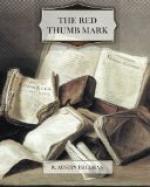“Ah!” said the judge; and his face relaxed into a dry smile, while the jury broke out into unconcealed grins.
“It was evident to me,” continued Thorndyke, “that the experts would be unable to distinguish the real from the forged thumb-prints, and, that being so, that they would look for some collateral evidence to guide them. I, therefore, supplied that collateral evidence. Now, if ten prints are taken, without special precautions, from a single finger, it will probably happen that no two of them are exactly alike; for the finger being a rounded object of which only a small part touches the paper, the impressions produced will show little variations according to the part of the finger by which the print is made. But a stamp such as I have used has a flat surface like that of a printer’s type, and, like a type, it always prints the same impression. It does not reproduce the finger-tip, but a particular print of the finger, and so, if ten prints are made with a single stamp, each print will be a mechanical repetition of the other nine. Thus, on a sheet bearing twenty finger-prints, of which ten were forgeries made with a single stamp, it would be easy to pick out the ten forged prints by the fact that they would all be mechanical repetitions of one another; while the genuine prints could be distinguished by the fact of their presenting trifling variations in the position of the finger.
“Anticipating this line of reasoning, I was careful to make each print with a different stamp and each stamp was made from a different thumb-print, and I further selected thumb-prints which varied as widely as possible when I made the stamps. Moreover, when I made the real thumb-prints, I was careful to put the thumb down in the same position each time as far as I was able; and so it happened that, on the sheet submitted to the experts, the real thumb-prints were nearly all alike, while the forgeries presented considerable variations. The instances in which the witnesses were quite certain were those in which I succeeded in making the genuine prints repeat one another, and the doubtful cases were those in which I partially failed.”
“Thank you, that is quite clear,” said the judge, with a smile of deep content, such as is apt to appear on the judicial countenance when an expert witness is knocked off his pedestal. “We may now proceed, Mr. Anstey.”
“You have told us,” resumed Anstey, “and have submitted proofs, that it is possible to forge a thumb-print so that detection is impossible. You have also stated that the thumb-print on the paper found in Mr. Hornby’s safe is a forgery. Do you mean that it may be a forgery, or that it actually is one?”
“I mean that it actually is a forgery.”
“When did you first come to the conclusion that it was a forgery?”
“When I saw it at Scotland Yard. There are three facts which suggested this conclusion. In the first place the print was obviously produced with liquid blood, and yet it was a beautifully clear and distinct impression. But such an impression could not be produced with liquid blood without the use of a slab and roller, even if great care were used, and still less could it have been produced by an accidental smear.




